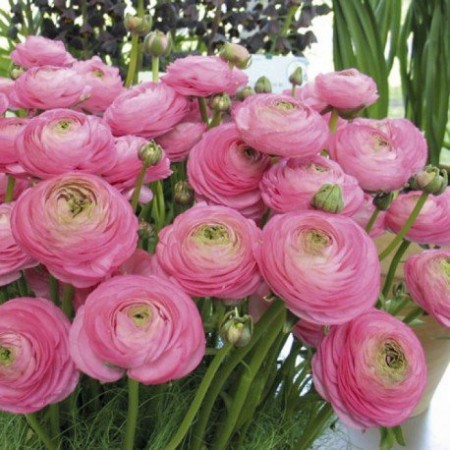Growing ranunculus

Ranunculus is an exotic plant species that has several hundred species in its family. With the right cut, this representative of the flora can stand in a vase for up to two weeks, and now we will try to figure out what rules should be observed when planting and growing ranunculus in a private summer cottage.
Site selection
Ranunculus loves sunlight, but the flower can grow quietly in dark places. Moreover, partial shade for him will be the best condition, since direct sunlight can quickly harm the leaves and buds, leaving them burns and leading to the death of the plant.
Ranunculus does not like sudden temperature changes and drafts, so when planting seeds in the soil, you should be sure that the winter coolness will not return. It is also recommended to provide special protection against drafts, fencing flowerpots with small structures made of polyethylene.
A drainage layer should be provided in the soil itself. You need to water the flower regularly, but one of the important conditions is that the soil should not retain fluid for a long time. Rotting of the root system is one of the most common problems that leads to the rapid death of a flower. Accordingly, before planting, place a small amount of sand or expanded clay at the very bottom of the hole.
Care after planting
If you follow the basic rules of planting (it is best to plant ranunculus not from seeds, but tubers), then you should determine how to properly care for seedlings.
We already said about watering (clarification - the first signs of problems with moisture congestion are the appearance of mold on leaves and dropping buds), which should be accompanied by a slight loosening of the soil. The next step in the care is the introduction of mineral fertilizers into the ground. It is recommended to perform this procedure at least once every two weeks, accompanying this, as before, with thorough loosening. The optimal period for fertilizing is the flowering period of ranunculus, and as a make-up it is recommended to use potash fertilizers: potassium sulfate, wood ash, potassium salt.
Young ranunculus is very susceptible to the appearance of various kinds of pests. The most common parasite that appears in a plant is aphids and thrips. The first signs of problems are the appearance of white and silver spots on the leaves, which should immediately be treated with an insecticide. For prevention, experienced gardeners recommend several times a week to treat the plant with a solution of mercaptophos (0.2 percent).